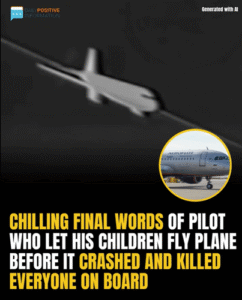What was meant to be a joyful and memorable experience for Relief Captain Yaroslav Vladimirovich Kudrinsky and his children turned into a catastrophic tragedy that shocked the aviation world and left a lasting scar on all who followed the story.
On the night of March 23, 1994, Aeroflot Flight 593, en route from Moscow to Hong Kong, ended in a deadly crash in the remote Kuznetsk Alatau mountain range, located in Russia’s Kemerovo Oblast.
The crash resulted in the deaths of all 75 passengers and crew members aboard, marking one of the most devastating and preventable air disasters in Russian aviation history.
The crew operating Flight 593 was among the most experienced and capable in the industry.
Captain Andrew Viktorovich Danilov, First Officer Igor Vasilyevich Piskaryov, and Relief Captain Yaroslav Kudrinsky had collectively flown thousands of hours, often together, and were known for their professionalism and expertise.
Their presence on the flight initially gave the airline and passengers confidence in a safe journey. However, despite their skills, the tragic events that unfolded demonstrated how critical adherence to safety protocols and strict cockpit discipline truly are.

Yaroslav Kudrinsky was accompanied by his two children on this flight: 13-year-old Yana and 15-year-old Eldar. The trip was not only a professional assignment but also a special occasion for the family, as it was the children’s first trip abroad. To make the moment unforgettable, Kudrinsky invited his children into the cockpit, intending to share his world with them. What began as a well-meaning gesture quickly became a dangerous breach of regulations — airline policies strictly prohibit non-crew members, especially minors, from entering the cockpit or interacting with controls during flight.
The crew believed it was safe to allow the children some cockpit access because the autopilot system was engaged. At approximately 12:43 AM, Yana sat in her father’s seat and pretended to “fly” the aircraft under the watchful eyes of the crew. Soon after, Eldar took over the controls, and in his youthful curiosity, he began manipulating the control stick.
Unknown to the crew, Eldar’s actions caused the autopilot to disengage. The aircraft switched from autopilot to manual control after Eldar’s control inputs lasted over 30 seconds and exerted forces of up to 10 kilograms, effectively overriding the autopilot’s commands. A warning light flashed briefly to alert the pilots to this critical change — a subtle signal that was unfortunately missed in the midst of the unusual cockpit activity.
Once the autopilot was disengaged, the plane’s stability was compromised. The aircraft began to bank to the left, and the pilots failed to recognize the shift in flight dynamics in time. Kudrinsky urgently ordered Eldar to remove himself from the controls, shouting warnings that were captured by the cockpit voice recorder: “Eldar, get away. Go to the back, go to the back Eldar! You see the danger don’t you? Go away, go away Eldar! Go away, go away. I tell you to go away!” Despite these efforts, the plane’s attitude continued to deteriorate.
In an attempt to recover, the pilots overcorrected, causing the plane to climb steeply. This led to an aerodynamic stall, where the aircraft lost the necessary lift to remain airborne, followed by an uncontrollable spin. The crew struggled desperately to regain control, but the combination of rapid altitude loss, confusion, and high-stress circumstances rendered recovery impossible.
At approximately 12:58 AM, Aeroflot Flight 593 crashed violently into the rugged Kuznetsk Alatau mountains, instantly killing all on board. The crash site was difficult to access, which complicated rescue and investigative operations, but authorities quickly began a thorough and exhaustive investigation into the causes of the disaster.
In the immediate aftermath, Aeroflot and Russian aviation officials initially denied pilot error, suggesting instead that mechanical failure or other external factors caused the crash. However, investigators painstakingly reviewed flight data from the aircraft’s flight data recorder and cockpit voice recorder, revealing the sequence of events with painful clarity.
The investigation concluded that the root cause of the crash was human error, compounded by violations of strict safety regulations. Allowing unauthorized passengers — especially children — into the cockpit and permitting them to manipulate controls was a critical breach. Additionally, the pilots failed to respond adequately to the autopilot disengagement warning and did not recognize or correct the abnormal flight behavior in time. This combination of factors led to the catastrophic loss of control and eventual crash.
This tragedy underscored the grave risks associated with complacency and breaches in protocol in the highly controlled environment of commercial aviation. It served as a sobering lesson to airlines worldwide, prompting reviews and tightening of cockpit security policies, including stricter prohibitions on non-essential personnel in the cockpit and greater emphasis on crew resource management to ensure vigilance and rapid response to anomalies.
Beyond regulatory changes, the emotional impact of the disaster resonated deeply with the families of victims, the aviation community, and the general public. Memorials were established to honor those who lost their lives, including ceremonies held at the crash site and at Aeroflot facilities. The memory of Flight 593 became a symbol of the importance of discipline and safety in aviation — a constant reminder that even experienced professionals must never deviate from established protocols.
The legacy of Aeroflot Flight 593 continues to influence pilot training programs globally. Its story is included in safety briefings and case studies to emphasize the catastrophic consequences of ignoring cockpit discipline and underestimating the dangers of seemingly small mistakes. The disaster has led to the development of more advanced cockpit warning systems and reinforced the critical importance of cockpit authority and the need to maintain clear boundaries within the flight deck.
In retrospect, the tragedy of Flight 593 was a perfect storm of human error, poor judgment, and lapses in safety culture. Yet, it also spurred improvements that have helped prevent similar incidents in the years since. While the loss of all 75 souls aboard is an indelible tragedy, their memory continues to inspire safer skies and a more vigilant aviation community.





